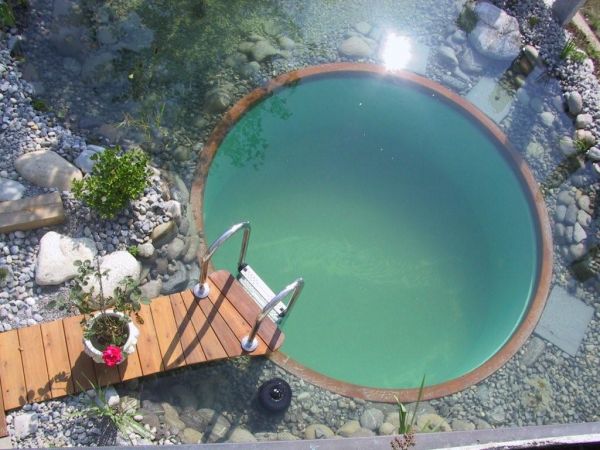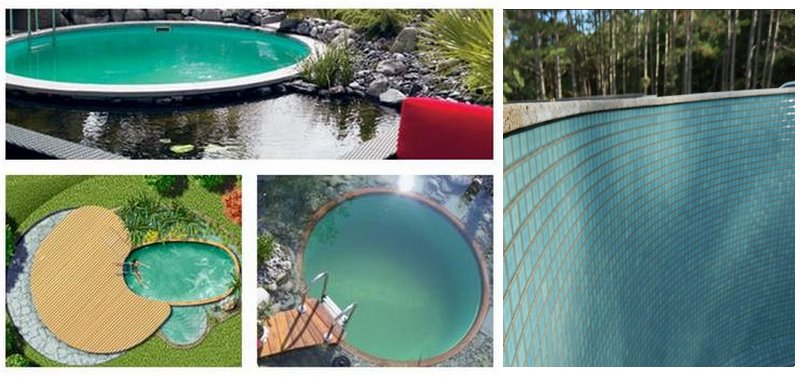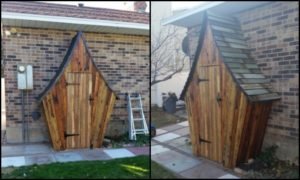Last Updated on March 10, 2025 by teamobn
With all that we’ve written about natural swimming ponds, it’s easy to look at some of the photos and assume that they only suit large yards. Nothing could be further from the truth. Today we’re going to cover natural plunge ponds..

The reality is that most pools are not used for swimming. They are used for entertaining – be it the kids or guests. Is a spa any less pleasant than a pool? Of course not. And spas offer some unique advantages over pools:
- They are usually very compact. A spa 2.4 metres in diameter will seat eight adults comfortably. In other words, a spa fits where a pool won’t.
- Spas are relatively shallow and therefore do not need vast quantities of water.
- Spas are easy to warm in winter and can be left unheated in summer for a more refreshing experience.
- Spas are much easier to install than a conventional pool.
But let’s face the real disadvantage… kids and adults tend not to mix well in spas. The kids want to splash and play while the adults want to relax and unwind. A pool wins hands down here as each can do their own thing.
Let’s look at a way to combine the best features of each of them by building a natural plunge pool. It offers compactness while retaining all the beauty and benefits of a natural pond!
The concept of natural plunge pools goes back many hundreds of years in Scandinavia and other parts of Europe. They have also been a part of some Asian cultures for at least that long. Japan, of course, has a whole culture built around thermally heated pools and ponds.
Contents
Safe for Kids, Fun for Everyone
When it comes to creating a natural plunge pool that is safe for kids and fun for everyone, there are a few key factors to consider. Above all, prioritizing safety is essential. Make certain that the site you select for your natural plunge pool is easily reachable and devoid of any potential dangers, such as jagged rocks or slick surfaces. Consider incorporating safety features such as a fence or barrier to prevent any accidents.
The design and features of your natural plunge pool play a significant role. Integrating features like waterfalls, jets, or perhaps even a slide can introduce an additional level of thrill that appeals to both children and adults.
Additionally, consider the addition of seating zones or even a built-in bar for those seeking relaxation and unwinding. By crafting a space that combines visual allure with practicality, you can guarantee that your natural plunge pool evolves into a central source of enjoyment for the entire family.
Experience Luxury in Your Backyard
When you’re in the process of creating your ideal natural plunge pool, one of the initial factors to think about is choosing the ideal location. Search for a site in your backyard that enjoys abundant sunlight all day long, as this will contribute to maintaining the water at a comfortably warm and inviting temperature.
Also, choose an area that is away from trees or other debris, as this will make maintenance easier and prevent leaves and branches from falling into the pool.
Building Your Dream Natural Plunge Pool
It requires careful planning and attention to detail to ensure that your dream plunge pool becomes a reality. To help you along the way, here are some tips to consider when building your natural plunge pool.
Tip #1
Buy a precast water tank, dig a hole, drop it in, do your landscaping and voila! You now have a natural plunge pond for a fraction of a conventional pool’s cost, effort and mess. You can literally go from dry to plunging in well under a week! What a great holiday project!
A quick bit of searching shows that a quality precast tank with a 3.75-metre diameter and 1.5-metre depth costs between $3,250 and $3,500. That’s a water capacity of around 10,000 litres. Of course, you will still need your filtration area but that is scaled accordingly.
Our search revealed that some manufacturers have the capacity to add a wider lip around the edge, thereby creating instant seating. Others are able to cast seating into the tank as it’s made!
Tip #2
One has the option to either preserve the natural state of the raw concrete or selectively apply tiling to the periphery or the entirety of the interior. It is imperative to acknowledge the presence of superior paint finishes that can also enhance the aesthetic appeal. Elevate the visual allure of your plunge pool.
Tip #3
Consider the surrounding landscape and ensure that there are no trees or plants with invasive root systems nearby that could potentially damage the pool structure. It is also important to take into account any potential drainage issues and ensure that the pool is properly designed to prevent water accumulation.

What do you think? Can you see a plunge pool in your future?
Filtration Systems for Natural Plunge Pools
A DIY natural plunge pool offers a relaxing and beautiful addition to any backyard. But maintaining clear, clean water without chemicals takes careful planning. An effective filtration system is key to keeping your pool healthy, safe, and enjoyable. Whether you want an eco-friendly approach or a low-maintenance option, understanding filtration methods will help you design a system that works for your plunge pool.
Why Filtration Matters in a Natural Plunge Pool
Natural plunge pools typically rely on a balance between plants, beneficial bacteria, and physical filtration to keep water clean. Without proper filtration, the water can quickly turn cloudy or stagnant, becoming a breeding ground for algae and insects. A good system maintains water clarity, controls harmful bacteria, and reduces maintenance efforts.
Biological Filtration Systems
Biological filtration is a popular choice for natural plunge pools. This method uses beneficial bacteria to break down organic waste and maintain water quality. A biofilter usually consists of a chamber filled with filter media—such as lava rock or specially designed plastic pieces—where bacteria colonize. Water flows through the media, and bacteria process waste materials like ammonia and nitrates. This type of system mimics nature’s way of purifying water and is ideal for chemical-free plunge pools.
Plant-Based Filtration (Regeneration Zones)
Many natural pools use plants to filter and oxygenate the water. Aquatic plants absorb nutrients that would otherwise feed algae. A regeneration zone, or planted area, works as a living filter. Water flows through the plant roots and gravel beds, where impurities are removed. Hardy plants like water lilies, reeds, and cattails are excellent choices for these zones. This system creates a balanced ecosystem and adds beauty to the pool area.
Mechanical Filtration Systems
Mechanical filtration helps remove debris like leaves, dirt, and insects from your plunge pool. Skimmers and bottom drains collect larger particles before they decompose. Adding a pump-driven filter, such as a sand or cartridge filter, can improve water clarity. These systems are simple to install and maintain and work well alongside biological or plant-based filtration.
Ultraviolet (UV) Clarifiers
A UV clarifier uses ultraviolet light to neutralize algae, bacteria, and other microorganisms as water passes through a UV chamber. While this system doesn’t replace filtration, it adds another layer of water treatment by killing unwanted pathogens. UV clarifiers work best when combined with a biofilter or mechanical system to ensure complete water cleanliness.
Choosing the Right Filtration for Your Plunge Pool
The best filtration system for your plunge pool depends on its size, design, and personal preferences. A combination of biological and plant-based filtration with some mechanical elements usually offers the best results. If you want a low-maintenance, eco-friendly system, focus on creating a healthy balance with plants and beneficial bacteria. For clearer water with less effort, consider adding a UV clarifier or mechanical filter to your setup.
Maintaining Your Filtration System
Regular maintenance ensures your filtration system works efficiently. Clean out skimmers and filters, trim plants, and check pumps and pipes for clogs or damage. Keep an eye on water levels and quality, especially during hot weather when algae growth can spike. A well-maintained filtration system will keep your natural plunge pool clean, clear, and inviting all year round.

Safety Features for DIY Plunge Pools
Building a natural plunge pool in your backyard can be a rewarding project. It creates a relaxing space for family and friends to enjoy. But safety should always be a priority, especially when water and outdoor environments are involved. Whether your DIY plunge pool is for adults, kids, or both, adding the right safety features will help prevent accidents and give you peace of mind.
Fencing and Barriers
One of the most important safety features for any DIY plunge pool is a secure barrier. Installing a fence around the pool keeps young children and pets from accessing it unsupervised. Look for self-closing and self-latching gates that meet local pool safety regulations. Even if your plunge pool is small, a fence adds an extra layer of protection.
Non-Slip Surfaces
The area around a plunge pool can become slippery, especially if you use natural stone, tiles, or decking. Choose non-slip materials for the pool deck and entry points to reduce the risk of falls. You can also add non-slip coatings or mats in high-traffic areas. This simple upgrade makes a big difference in keeping your DIY plunge pool safe for everyone.
Shallow Zones and Steps
Design your DIY plunge pool with easy and safe access in mind. Wide steps, shallow zones, or built-in benches allow swimmers to enter and exit the pool comfortably. These features are especially helpful for children or older adults. Gentle slopes instead of steep drop-offs can also enhance safety.
Pool Covers
A sturdy pool cover helps prevent accidents when your plunge pool isn’t in use. Look for covers designed to support weight, so they act as a barrier if someone accidentally steps onto them. Covers also keep debris out of the water and reduce maintenance, making them a practical safety feature.
Clear Visibility
Good visibility is key to keeping an eye on swimmers. Avoid placing your DIY plunge pool in areas where trees, walls, or landscaping block the view. If possible, position it near the house or outdoor seating areas. You’ll be able to supervise swimmers easily, whether they’re kids playing or adults relaxing.
Emergency Equipment and Rules
Have basic safety equipment nearby, like a life ring, reaching pole, or first aid kit. Even for a shallow plunge pool, these tools can be life-saving in an emergency. It’s also smart to establish pool rules, such as no running, no diving, and always supervising young swimmers.
Adding these safety features to your DIY plunge pool helps ensure a fun and worry-free experience. It creates a space where everyone can relax, knowing that precautions are in place to keep them safe.
The Wrap Up
In this article, you’ve found expert DIY tips for successfully crafting your very own natural plunge pool. This emphasizes the importance of site selection, guiding you to choose areas. This also dives into the intricacies of material and equipment selection, ensuring your plunge pool is not only functional but also harmoniously blends with its natural surroundings.
Armed with these three invaluable tips, you’ll be well-prepared to begin your exciting journey towards fashioning a serene and natural plunge pool right in the heart of your own backyard. These expert insights will act as your compass, guiding you through the intricacies of the transformation process.
As you progress, every endeavour you undertake will gradually shape your outdoor space into something far grander than a conventional backyard. It will transform into a distinctive personal sanctuary, a haven that exudes relaxation, reinvigoration, and boundless enjoyment for each and every member of your cherished family.
Are you ready to make your own natural plunge pool?
We have more amazing plunge pool projects. Check out our pallet plunge pool guide next!






